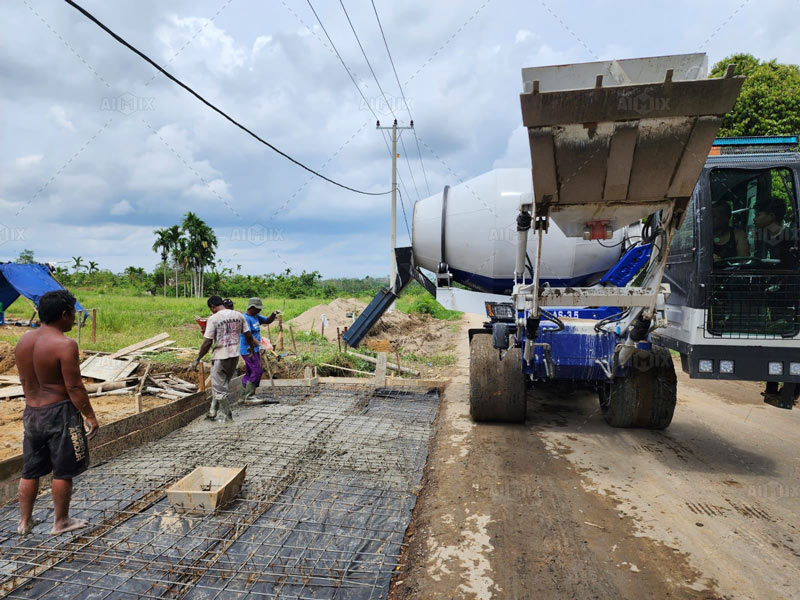Self-loading concrete mixers are widely used in construction projects due to their efficiency and versatility. A key factor contributing to their effectiveness is the incorporation of automatic control systems. But do all self-loading mixers use these systems, and how do they enhance operations? This article explores the role of automation in self-loading concrete mixers and its benefits.
How Self-Loading Concrete Mixers Work
The Functionality of a Self-Loading Mixer
A self-loading concrete mixer(autohormigonera) combines multiple functions into one machine, including loading, mixing, transporting, and discharging concrete. It features a rotating drum and a loading bucket that allows operators to add raw materials directly into the mixer. The ability to load materials automatically reduces manual labor and enhances efficiency.
Key Components of a Self-Loading Mixer
- Loading bucket – Facilitates automatic loading of raw materials.
- Mixing drum – Rotates to ensure uniform mixing.
- Water tank – Controls the precise water-to-cement ratio.
- Hydraulic system – Powers the loading and mixing operations.
- Operator’s cabin – Provides a comfortable control environment.
- Engine and Transmission – Ensures smooth mobility and power distribution.
- GPS and Monitoring System – Tracks operations for better control and efficiency.

The Role of Automatic Control Systems in Self-Loading Mixers
What Are Automatic Control Systems?
Automatic control systems in self-loading concrete mixers(auto hormigonera Bolivia) involve the use of sensors, software, and hydraulic controls to regulate mixing, water dosage, and discharge processes. These systems ensure consistency in concrete quality and reduce errors caused by manual operation.
Types of Automatic Control Features
- Electronic Weighing System – Measures the exact quantity of materials to maintain mix proportions.
- Water Flow Meter – Ensures precise water dosage for optimal consistency.
- Drum Rotation Control – Adjusts speed and direction to achieve uniform mixing.
- Automated Discharge Mechanism – Regulates the unloading process to minimize waste.
- GPS Tracking and Remote Monitoring – Provides real-time data on machine performance and location.
- Self-Diagnosing System – Detects faults and alerts operators for maintenance.

Benefits of Automatic Control in Self-Loading Concrete Mixers
Improved Efficiency and Productivity
Automation eliminates the need for manual adjustments, enabling faster mixing and reducing cycle times. This allows construction teams to complete projects more quickly.
Consistent Concrete Quality
By using precise electronic weighing and water measurement, self-loading mixers of AIMIX Machinery with automatic control systems produce uniform concrete batches, reducing material wastage and ensuring high-strength structures.
Reduction in Manual Labor and Costs
Since self-loading mixers handle multiple tasks with minimal human intervention, labor costs are significantly reduced. Additionally, automation minimizes operator fatigue, improving safety on-site.
Enhanced Data Tracking and Monitoring
Advanced self-loading mixers come equipped with digital displays and GPS tracking, allowing operators to monitor mixing parameters and ensure compliance with construction standards.
Lower Maintenance Costs
Automatic self-diagnosing systems can detect operational issues early, preventing costly breakdowns and prolonging machine life.
Do All Self-Loading Mixers Use Automatic Control Systems?
While many modern self-loading mixers integrate automatic control systems, not all models feature advanced automation. Entry-level or budget-friendly models may have manual control options, requiring operators to adjust material quantities and water dosage manually. However, high-end models from leading manufacturers come equipped with fully automated systems for superior performance and efficiency.
The Evolution of Self-Loading Mixer Automation
Over the years, self-loading mixers have advanced from simple manually controlled machines to highly automated units. The integration of GPS tracking, remote monitoring, and AI-driven adjustments has improved their functionality and ease of use. Future developments may include autonomous operation and further enhancements in predictive maintenance.
Choosing the Right Self-Loading Mixer for Your Needs
Consider Your Project Requirements
For small-scale projects, a basic self-loading mixer with minimal automation may be sufficient. However, for large-scale construction projects, investing in a fully automated model ensures higher productivity and precision. And you can click this link for more information about how to customize your mixer: https://aimixgrupo.com/autohormigonera/autohormigonera-paraguay/
Evaluate the Features and Specifications
Look for key automation features such as electronic weighing, drum rotation control, and water metering when selecting a self-loading mixer. Additionally, consider the engine power, drum capacity, and mobility for optimal performance.
Compare Brands and Manufacturers
Leading manufacturers offer various self-loading mixers with different levels of automation. Researching and comparing options based on durability, after-sales service, and technological advancements can help in making an informed purchase decision.
Cost vs. Value
While fully automated self-loading mixers may have a higher initial investment, they often provide long-term savings through increased efficiency, lower labor costs, and reduced maintenance expenses.
Conclusion
Self-loading concrete mixers with automatic control systems provide numerous advantages, including enhanced efficiency, reduced labor costs, and consistent concrete quality. While not all models feature full automation, investing in an advanced self-loading mixer can significantly improve construction productivity. When selecting a mixer, evaluating automation features, project needs, and manufacturer reputation ensures the best choice for your operations. As technology continues to evolve, self-loading mixers are likely to become even more efficient, further revolutionizing the construction industry.
